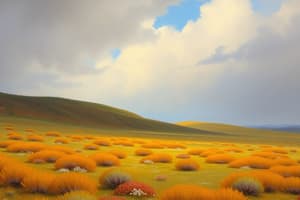Podcast
Questions and Answers
What are the three types of tundra ecosystems?
What are the three types of tundra ecosystems?
Alpine, arctic, and antarctic.
Where is the alpine tundra ecosystem found?
Where is the alpine tundra ecosystem found?
On tall mountains.
Where is the arctic tundra found?
Where is the arctic tundra found?
At the top of the world around the North Pole.
What is very similar to arctic tundra ecosystems?
What is very similar to arctic tundra ecosystems?
What are characteristics of the arctic tundra ecosystem?
What are characteristics of the arctic tundra ecosystem?
What are biomes?
What are biomes?
What is the Earth's coldest and youngest biome?
What is the Earth's coldest and youngest biome?
How was the arctic tundra formed?
How was the arctic tundra formed?
What percentage of the Earth is arctic tundra?
What percentage of the Earth is arctic tundra?
What does the word tundra mean?
What does the word tundra mean?
What is the permafrost layer?
What is the permafrost layer?
What is the active layer?
What is the active layer?
How many seasons does the arctic tundra have?
How many seasons does the arctic tundra have?
What are some herbivores in the arctic tundra?
What are some herbivores in the arctic tundra?
What are some predators in the arctic tundra?
What are some predators in the arctic tundra?
What are the producers on the tundra?
What are the producers on the tundra?
What adaptations help plants survive on the tundra?
What adaptations help plants survive on the tundra?
What adaptations do animals have that protect them?
What adaptations do animals have that protect them?
How do arctic plants reproduce?
How do arctic plants reproduce?
What adaptations do the arctic plant leaves and stems have to help survive in the arctic ecosystem?
What adaptations do the arctic plant leaves and stems have to help survive in the arctic ecosystem?
How does growing close to the ground help plants survive?
How does growing close to the ground help plants survive?
Why would the plant have small leaves?
Why would the plant have small leaves?
Why can't plants with deep roots live in the arctic tundra?
Why can't plants with deep roots live in the arctic tundra?
What are some examples of arctic vegetation?
What are some examples of arctic vegetation?
How is the tufted saxifrage different from other vegetation?
How is the tufted saxifrage different from other vegetation?
Why do tundra plants grow so close to the ground?
Why do tundra plants grow so close to the ground?
What is lichen?
What is lichen?
Why do some arctic plants have red or dark-colored leaves?
Why do some arctic plants have red or dark-colored leaves?
Flashcards are hidden until you start studying
Study Notes
Tundra Ecosystems
- Three types of tundra ecosystems: alpine, arctic, and antarctic.
- Alpine tundra located on tall mountains.
- Arctic tundra is found at the North Pole and is characterized by a dry, flat, and treeless landscape, often covered in snow and ice for up to 10 months a year.
- Antarctic tundra ecosystems share similarities with arctic tundra.
Characteristics and Formation
- Arctic tundra is the coldest and youngest biome on Earth.
- Formation of the arctic tundra occurred as glaciers retreated during the last ice age.
- Arctic tundra covers approximately 20% of the Earth's surface.
Tundra Definition and Layers
- The term "tundra" refers to treeless, flat land.
- Permafrost is an underground layer that remains frozen all year.
- The active layer is the top few centimeters of soil that thaws in summer and refreezes in winter.
Seasons and Wildlife
- The arctic tundra experiences two seasons: summer and winter, with winter lasting about 10 months.
- Herbivores like musk-ox inhabit the region.
- Predators such as the arctic wolf roam the tundra.
Vegetation
- Producers in the tundra include plants and lichens, which are a symbiotic relationship between fungi and algae or bacteria.
- Tundra plants have adaptations, like low growth and clustering, to withstand harsh winds and minimize cold exposure.
- Arctic plants reproduce primarily through new roots instead of seeds due to the short growing season.
Plant Adaptations
- Dark leaves and stems help arctic plants absorb more sunlight and warmth.
- Growing low to the ground reduces thermal energy loss and damage from winds.
- Small leaves are common to minimize water loss through transpiration.
- Deep roots are ineffective in arctic tundra due to permafrost barriers.
Arctic Vegetation Examples
- Common plants include cotton grass, sedge, arctic willow, dwarf heath, mosses, and lichens.
- Tufted saxifrage is notable for producing numerous small seeds and growing to about 6 inches tall while forming dense mats.
- Tundra plants close to the ground mitigate the impact of cold winds.
Lichens
- Lichens function as producers and consist of a fungus paired with algae or bacteria, playing an essential role in the tundra ecosystem.
- Some arctic plants feature red or dark-colored leaves to better harness solar heat.
Studying That Suits You
Use AI to generate personalized quizzes and flashcards to suit your learning preferences.




